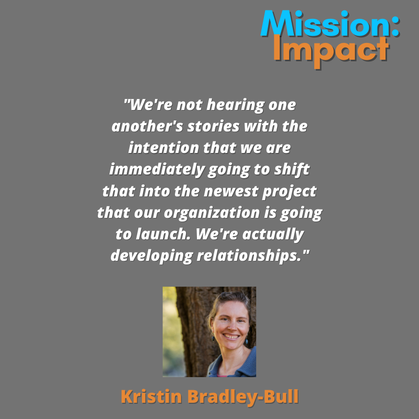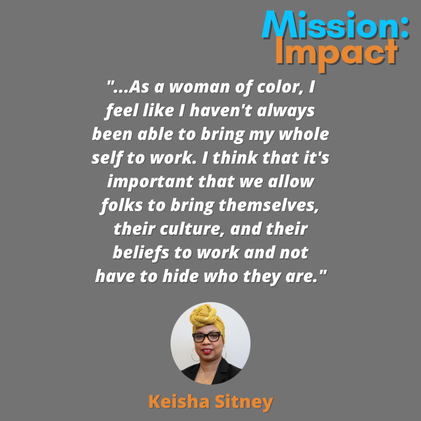Mission: Impact podcast & blog
Build a better world without becoming a martyr to your nonprofit cause
Listen on:
 In episode 25 of Mission: Impact, some of the topics that Carol and her guest, Kristin Bradley-Bull discussed include:
Kristin Bradley-Bull’s tagline says it all: “Illuminating your vision. Extending your vast roots and branches to get there.” She runs Roots to Canopy in Durham, NC. At Roots to Canopy, Kristin consults with non-profits to develop powerful strategies and plans – and to develop staff capacity to be wildly successful in making change in the world. She does the same in her coaching practice: supporting people to crystalize their vision and orient toward their North Star – as non-profit leaders and as humans. Kristin loves people, justice, organizations and movements, and transformation on all levels. Her background includes co-founding a training and leadership non-profit, being a full-time public health faculty member, and consulting (20 years+) with organizations ranging from multilaterals to grassroots social justice groups. Important Guest Links: The book mentioned during the show is Forces for Good: The Six Practices of High-Impact Nonprofits by Leslie R. Crutchfield and Heather McLeod Grant Information on the size of the nonprofit sector in the US: https://nccs.urban.org/publication/nonprofit-sector-brief-2019#the-nonprofit-sector-in-brief-2019 Divorcing White Supremacy Culture website http://www.whitesupremacyculture.info/ Click "Read More" for Transcript:  There is a brief discussion of police brutality in this episode around 16 minutes in. In episode 14 of Mission: Impact, some of the topics that Carol and her guest, Keisha Sitney, discussed include: - Why leaders need to be role models for their staff and lead by example - Why organizations need to start with individuals when working on equity - How to build the leadership capacity of people who haven’t traditionally been promoted to leadership roles - Why it is important to not just teach people of color to be like “traditional” white leaders but encourage them develop their own leadership style - How professionals focusing on diversity, equity, and inclusion experience profound fatigue in continually educating people about racism and other forms of oppression.
Keisha Sitney is the Chief People Officer for The Y in Central Maryland and the founder of Golden Key Coaching. She works to ensure the people strategies and resources support and match the strategic priorities of the organization. Keisha is an executive leader who has been with the Y for 30 years, both at the national and regional levels. With in-depth experience in coaching, talent management, strategic visioning and planning, and facilitation, Keisha has served in operational roles at the YMCA of Metropolitan Washington, led the national multicultural leadership development movement as well as served as an internal consultant for C-Suite leaders from Ys across the United States. She holds a Master's Degree in Organization Development from American University and a Bachelor's Degree in Psychology from Howard University. Links:
Click "Read More" for Transcript: |
Archives
April 2024

Grace Social Sector Consulting, LLC, owns the copyright in and to all content in and transcripts of the Mission: Impact podcast, as well as the Mission: Impact blog with all rights reserved, including right of publicity.
|
Telephone301-857-9335
|
info[at]gracesocialsector.com
|
Grace Social Sector Consulting, LLC, owns the copyright in and to all content in, including transcripts and audio of the Mission: Impact podcast and all content on this website, with all rights reserved, including right of publicity.
|